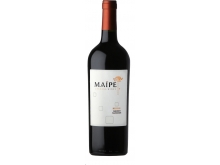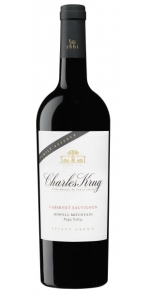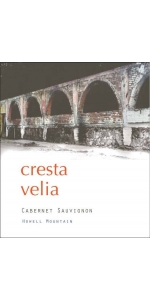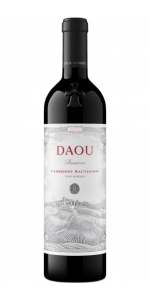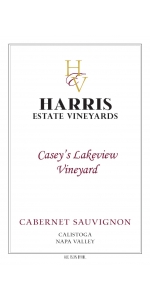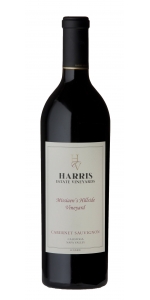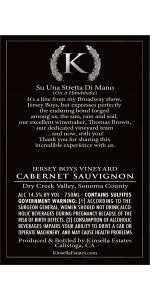Maipe Cabernet Sauvignon Reserve 2014
| Country: | Argentina |
| Region: | Mendoza |
| Winery: | Maipe |
| Grape Type: | Cabernet Sauvignon |
| Vintage: | 2014 |
| Bottle Size: | 750 ml |
Charles Krug Family Reserve Howell Mountain Cabernet Sauvignon is made from 100 percent Napa Cabernet Sauvignon.
Rising 1,650 feet above the Napa Valley floor on the southwestside of Howell Mountain, the Family Reserve Howell MountainCabernet Sauvignon sits above the fog line. The distinctiveclimate, along with volcanic and iron-rich red soils, producefruit with great balance and intensity.
Review:
The 2017 Cabernet Sauvignon Limited Release Cold Springs is the most distinctive of the wines in this range of limited-release Cabernets from Charles Krug. Gravel, licorice, menthol and spice all develop in a Howell Mountain Cabernet endowed with tremendous class and nuance.
-Vinous 92 Points
Early to bud and early to ripen, the 2014 vintage was our third drought year in a row. Dry, even temperatures marched the grapes along at a steady clip all year and created a wine with beautifully integrated fruit, acidity, and tannin.
Dense and dark magenta in color, this is a lithe and energetic vintage with lifted aromatics and a purity of fruit that lights up the medium-bodied tannin structure. The nose promises fresh black fruits, cherries and a touch of graphite, and the palate completely delivers. Juicy blackberry, plum, and bright cherry explode in the mouth, and develop into savory notes of baked black fruit and fresh pencil shavings on the mid-palate.
Eagle Summit Vineyard’s signature eucalyptus appears on the back palate to brighten the fruit, showing fragrant peppermint and warm, toasty spices through the finish. Whether you open it young or wait a few decades, this vintage does Howell Mountain proud--sophisticated and smart, with a rustic wild side.
Cresta Velia Cabernet Sauvignon Howell Mountain is made from 100 percent Cabernet Sauvignon.
Aged in 100% French oak (86% new)
• 100% Cabernet Sauvignon from Eagle Summit Vineyard on Howell Mountain
• Equal amounts of clone 4 and clone 7
• unfined and unfiltered
Review:
"The 2014 Cabernet Sauvignon is 100% Cabernet aged 20 months in 86% new French oak, with the typical suspects in terms of cooperage – Darnajou, Taransaud, and Remond. This opaque purple-colored wine has plenty of mulberry and blackcurrant fruit along with hints of blackberries, camphor and incense. The are some notes of unsmoked cigar and licorice as well. Ripe, medium to full-bodied and luscious, it is a classic to drink over the next 15 or more years. - RP"
- Robert Parker's Wine Advocate (Issue #228, December 2016), 90 pts
DAOU Vineyards Reserve Cabernet Sauvignon is made from 77% Cabernet Sauvignon, 23% Petit Verdot.
The 2021 DAOU Reserve Cabernet Sauvignon is emblematic of Paso Robles as a world-class region for Bordeaux-style wines. Intense purple-red hues foreshadow deep aromas of black fruit, pomegranate, tobacco, mocha, and bay leaf. Trailing notes of clove, nutmeg, and vanilla emerge as the wine opens up in the glass. Opulent textures expand across the palate with flavors of red fruit, blueberry, and chocolate-covered raspberry. The overall experience is fresh and rich, concluding with velvety tannins and impressive length.
Review:
Dark and focused aromas of cherry, clove and caramel meet with creamy milk chocolate and mahogany on the layered nose of this bottling. Showing a deft mastery of tannins, which is the Daou hallmark, the palate is silky and yet structured, offering rich fruit and lightly bitter walnut flavors.
-Wine Enthusiast 95 Points
The Cabernet Sauvignon Casey’s Lakeview is similarly inky bluish/purple to the rim. Tasting like blood, this wine is dense and rich with lots of chocolate, espresso, earth and spice. It is deep, full-bodied, and again, a masculine style of wine that needs at least 4-5 years of cellaring and should keep for 25 or more years.
Lakeview Vineyard is the winery’s mid-block vineyard planted to a combination of clone 6 & 337 Cabernet Sauvignon on 101-14 rootstock. Excellent drainage from the rocky and chalky soils plus plenty of sunlight throughout the day produces wines of bold character with mouth filling flavors.
Organic farming methods are used to produce this Cabernet Sauvignon Casey's Lakeview vineyard. Vines are 17 years old. Ageing in French oak barrels (85% new) for 20 months, then 12 months in bottle prior to release. Non-filtered.
Review:
"The 2014 Cabernet Sauvignon Casey's Lakeview Vineyard is the most overt of these wines. Superripe black cherry, plum, chocolate and licorice add to an impression of flamboyance that sits on the edge of being too much. The effects of the drought are felt in the wine's slightly roasted profile. - Antonio Galloni"
- Antonio Galloni's Vinous (December 2016), 91 pts
Heritage School Missiaens Hillside Cabernet Sauvignon is made from 100 percent Cabernet Sauvignon.
A steep, rocky site with red volcanic soils results in our most structured and concentrated wine. Planted in 1998 using 110R rootstock and clone 337 Cabernet Sauvignon our Hillside Vineyard produces wines as breathtaking as the views from its slopes. These tiny, dark blue berries ripen near the end of September thanks to cool afternoon temperatures allowing for increased hang time and developed flavors.
Reviews:
"The 2014 Cabernet Sauvignon Missiaen's Hillside Vineyard is the darkest and richest of these wines, but it also has enough structural breadth to handle all of that intensity. Superripe plum, bittersweet chocolate, tobacco and licorice all flesh out over time. This is an especially rich, seamless style, yet all the elements are in the right place. - Antonio Galloni"
- Antonio Galloni's Vinous (December 2016), 92 pts
Pure 100% cabernet Sauvignon, this vineyard continually astonishes. Loads of loamy soil notes followed by blue and black fruits give this cabernet massive depth and beautiful integrated tannins. Milk chocolate, crème de cassis and tobacco give this massive wine the depth you come to expect with Napa cabs, but it is all Sonoma County, all from our magnificent little private valley which sees sun all day! We buy no fruit; we sell no fruit.
Jersey Boys Vineyard (Kevin Kinsella is the largest individual investor in the hit Broadway show "Jersey Boys")
Jersey Boys is a six-acre vineyard that was replanted in 2008 with four different clones of Cabernet Sauvignon, handpicked by winemaker Thomas Rivers Brown.
“While it was the third consecutive year marked by limited rainfall, the 2014 vintage offered a perfectly temperate growing season characterized by long, moderate days and cool, clear nights. We began the year with warm spring conditions that gave way to an early budbreak and the consistent, dry weather afforded an optimal fruit set of small berries with incredible concentration. Crop yields were down a bit from 2013, but the quality was magnificent. It was a textbook growing season, every winemaker’s dream.”
- Winemaker Thomas Rivers Brown
Any vegetable or meat in the grill. Delicious with Chocolate as well.
Review:
"There are 645 cases of the 100% Cabernet Sauvignon 2014 Cabernet Sauvignon Jersey Boys Vineyard (named after the fact that the Broadway Musical “Jersey Boys” was brought to the stage and screen by the owner of Kinsella). This wine and its siblings will do a lot to establish Dry Creek as more than another viticulture area better known for Zinfandel than Cabernet Sauvignon. This is a killer Cabernet Sauvignon with dazzling fruit levels and loads of loamy soil notes intermixed with black raspberry, blueberry and blackcurrant. The superripe and pure fruit hits the palate with a full-bodied crescendo. The wine offers up notes of underbrush, unsmoked cigar tobacco, pen ink and plenty of crème de cassis and blackberry, Drink it over the next 20-25 years. - RP"
- Robert Parker's Wine Advocate (Issue #227, October 2016), 95 pts
Maipe Cabernet Sauvignon Reserve is 100 percent Cabernet.
A ripe, fleshy style, with blackberry and fig sauce notes laced with bittersweet Grenache. Powerful and layered, with classic Cabernet aromatics. Dark and ripe, with a nice loamy edge lurking on the finish.
70% of the resulting wine is aged for 12 months in French oak barrels to fully reveal the character of the Andean terroir, and the remaining 30% is aged in concrete vats.
The grapes are carefully chosen and fermented in small lots to preserve the vineyard identity.
Alcoholic fermentation for 10 days with indigenous and selected yeasts, at temperatures of 26 and 30°C, combining, remontage, pigage and delestage in order to obtain the best quality of tannins and structure.
Review:
"Fascinating aromas of dark berry, dried flower and fresh herb. Full body, tight and ripe fruit and a juicy finish. Very pretty length and firmness. Drink or hold."
- James Suckling (May 23rd 2016), 92 pts
The Maipe Estate
Looking for Chakana's other labels?
Click below:
Maipe was the Lord of the Winds for the ancient Andean people. Argentineans still invoke his name to clear the skies after a heavy rain or to temper the summer heat. These wines, children of the Sun and the Winds, are produced from grapes grown at the foothills of the Andes Mountains at an altitude of 3,000 feet above sea level. The intense color and aromas capture the expression of the soils that gave them birth.
Maipe is produced in a state-of-the-art winery, Chakana, built with the purpose of achieving outstanding quality.
Chakana winery was founded by Juan Pelizzatti on May 2nd, 2002. Juan was driven to enter the wine industry first and foremost by his passion for wine, and also by the desire to invest his time and money on a product of agriculture. Although Juan did not know it at the time, the company was founded on the same day the Chakana was celebrated on the Andes highlands: on that same day, the Southern Cross (the Chakana for the Inca people) becomes vertical in the night Andean sky.
Juan's mission is to create an integral experience to introduce world consumers to the taste and culture of the Andes. His vision is to become one of the top 20 exporters of wine from Argentina, by consistently offering outstanding value for money.
Wine is currently produced in four different levels at Chakana, by winemaker Gabriel Bloise:
Entry Level: Maipe
Reserve Level: Maipe Reserve, Cueva de las Manos, Nuna
Estate Selection
Ayni
The winemaking process is focused on treating the grapes with great care and with strict control of every step of the production.
Wines are designed under the responsibility of the renowned international wine consultant Alberto Antonini.
The winery is located on a 150 ha. estate, 34 km South of the city of Mendoza, in Agrelo, Lujan de Cuyo.
The grapes grown are 35 year-old Malbec, Bonarda and Cabernet Sauvignon.
Deep and textured soils facilitate plant development and confer great body and structure to the wines.
The year-long sunny and dry conditions allow almost organic viticulture practices. The outstanding feature includes a great daily thermal amplitude, with mild days and cold nights, permitting a particular richness of polifenols that improves the wines flavors and color.
A drip irrigation system has been set up to achieve a precise control of the vegetative cycle and a rational use of water. Waters are processed and used in the vineyards.
The Maipe Vineyards
Chakana sources grapes from their own four estates:
Agrelo
Acreage: 150 ha, 120 ha with vineyards
70 ha entry level
40 ha reserve level
10 ha estate & ayni
Acreage by varietal at Agrelo Estate:
Malbec: 50 ha
Cabernet Sauvignon: 30 ha
Syrah: 10 ha
Bonarda: 10 ha
Tannat: 2,5 ha
Petit Verdot: 2.5 ha
Cabernet Franc: 1.5 ha
Aspirant Bouchet: 2.5 ha
Ancellotta: 2 ha
Sauvignon Blanc: 4 ha
Viognier: 2.5 ha
Chardonnay: 2.5 ha
Wine Profile: Medium bodied, elegant, fresher fruit. Round tannin on gravels.
Terroir: Very heterogeneous – deep clay to sandy clay gravels; cool climate
Altamira I
Acreage: 15 ha, Malbec high density. Planted in 2010, not in production
Wine Profile: Full bodied, impressive tannic structure and roundness, spicy and complex.
Terroir: Sandy clay gravel, limestone; cooler climate
Altamira II
Acreage: 36 ha, 26 ha with vineyards
20 ha malbec, estate and ayni level
4 ha chardonnay, entry level and reserve
2 ha pinot noir (used for sparkling wine)
Wine Profile: Medium bodied, elegant, fresher fruit. Round tannin on gravels.
Terroir: Very heterogeneous – deep clay to sandy clay gravels; cool climate
Terrada
Acreage: 21 ha, all in vines
100% malbec, old vines, high density
Reserve – Estate Selection
Wine Profile: Complex, ripe fruit, medium bodied, elegant.
Terroir: Sandy clay gravels, 70cm. soil depth, Some limestone; warmer climate.
They also source wines from contract suppliers in Ugarteche and Medrano, for entry level wines, and in Vista Flores, for Estate Selection & Ayni levels.
- back
Arzuaga Gran Reserva 95% Tempranillo, 4% Cabernet Sauvignon and 1% Merlot.
Presenting a ruby red color, this wine has a wide range of aroma of ripe fruit compote, toast, and leather. Fine, complex, and attractive with a great balance. Silky and pleasant in the mouth with a bit of spice detected in the finish.
Serve with red meats, roasts, or game dishes. Its flavor is enhanced with cured or fatty cheeses.
Review:
Big, bold, and age-worthy, the 2019 Gran Reserva is the biggest production yet from the producer of this wine at 9,423 bottles. Salty and spicy, it’s voluminous, richly layered in concentrated, full-bodied swaths of sweet red berry, toasted oak, balsamic, and tobacco. After 40 months in French oak, the tannins are sweet and melty.
-Jeb Dunnuck 98 Points
Holocene Aureolin Chardonnay is made from 100 percent Chardonnay.
Native yeast, no SO2 added at crush
Fermentation in stainless and neutral oak, including feuillettes
Elevage – 9 months in 50% new oak
164 cases produced

